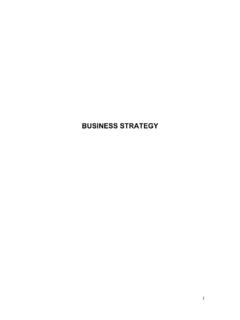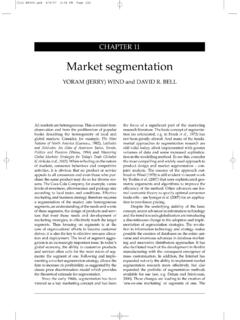Transcription of Finally: Customer Analytics for Banks - Deloitte
1 Finally: Customer Analytics for Banks That 360-degree view of the Customer you ve been talking about? Now Analytics brings it within reach for Banks . How well do you know your customers? Ask that question of leaders at most Banks , and they ll likely answer pretty well, thanks. But is that enough? Not these days at least not for Banks looking to stay a step ahead of the competition. Customer behavior and preferences are changing at a more rapid clip than at any moment in recent history propelled by changes in technology and the economic environment. Banks that have built their organizations with a product-oriented focus ( if we build it, they will come ) should consider shifting to a more Customer -centric footing in order to stay competitive.
2 One way to effectively make that transition is to cultivate the seemingly mythical 360-degree view of the Customer one that accounts for their current value as well as their potential lifetime value. The truth is, Banks often have deep insights into their customers in fact, compared with many other industries they are generally ahead of the curve. The issue lies in the fact that these insights are often not shared across the organization. While regulatory requirements can constrain the widespread sharing of Customer data, there is still much that can be done to pull Customer information up and out of silos to begin creating a more broad, centralized, enterprise-level view of customers. Finding and sharing the required data at the relevant levels is only the start.
3 The question then becomes: How can you use the data to discover Customer insights? The systems and processes in place throughout most Banks are generating more data than ever before, and it s only growing. There s a very good chance that after pulling together these different strands of data, the organization won t know how to effectively use it. At least not by using the same old data and information management approaches. After years of investing heavily in business intelligence, it s fair for many Banks to wonder if there s really a difference between real business Analytics and the capabilities they ve developed as part of their business intelligence (BI) investments. The good news is that BI still has an important foundational role to play in Analytics in simple terms, it s great for slicing and dicing data to understand what happened in the past and monitor key performance indicators.
4 Core platform implementations, back-office consolidations, transaction pricing assessments these are prime examples of BI applications. The limitation is they stop short of anticipating what may be just around the corner. If BI is about hindsight, Analytics is about foresight predicting and improving to generate more effective future results. Predictive modeling and performance management are just two examples of the types of activities that companies undertake with an Analytics approach. So where does it come into play in creating that 360-degree view of the Customer ? Customer Analytics : Four key areas Theoretically, Analytics can be applied to uncover deeper insights anywhere a bank has been collecting data.
5 This does not mean discovering each analytical insight is efficient in fact, one of the most significant dangers of Analytics is spending valuable time and resources pursuing the wrong insights. In our experience, there are four areas that are prime targets for an Analytics approach. Customer acquisition It s one thing to uncover facts about your customers long after they ve already signed up for your services. But think of how powerful it could be to develop real-time insights into individual prospects to more effectively inform the organization s interactions with them as they make their way through the sales process. Better yet, consider the powerful effect of using these types of insights to generate interest in your products and services on a Customer -by- Customer basis.
6 To develop and implement an effective Customer -acquisition strategy, Banks should have data and analytical experience as well as marketing and measurement capabilities. Together, these capabilities can help clients acquire customers, automate processing and decision making, manage Customer accounts, and reduce Customer acquisition costs and risks. Banks should target their prospects more effectively by identifying potential customers and matching their business objectives using market research, market surveys, psychographic profiles and Analytics tools to segment the Customer pool. With more targeted, relevant messaging for offers, Banks can improve their Customer acquisition ability. They should also determine the most effective offer available to those prospects by setting the most effective lending terms using scoring and segmentation tools.
7 And they should determine which consumers will be profitable in the long run while presenting the least amount of risk. From there, Banks should consider originating offers to the Customer groups they identified. Here are some questions Banks need to consider in order to effectively execute these steps: Perform historical prospect economics: Has the bank analyzed historical performance of new customers based on initial balances, utilization, profitability , and more? Segment prospect: Has the bank identified groups of prospects that are internally similar and externally different from other groups of prospects? Measure prospect campaign effectiveness: Has the bank evaluated the effectiveness of actual prospect marketing campaigns relative to expectations?
8 Estimate prospect potential: Has the bank estimated the potential value of each prospect to assist in prioritizing prospects? Project prospect fraud likelihood: Has the bank estimated the likelihood that prospective customers and accounts are fraudulent? Estimate prospect price sensitivity: Has the bank estimated the prospect price elasticity? Estimate prospect offer response rate: Has the bank estimated the likelihood of prospect response based on offer characteristics? Improve prospect acquisition offer: Has the bank identified prospects for action and determined the most appropriate offers including product, pricing, channel, marketing message, and timing-to improve management s volume and profit objectives?
9 Service Once customers are acquired, many Banks face the challenge of servicing them. Today s customers are far more sophisticated than ever, forcing Banks to answer critical questions such as: How often should a bank contact a particular Customer ? Through which channels should I service this Customer ? To further complicate this relationship, new restrictions on fee income and interest rates make it even more important to understand the economics of each Customer and find ways to gain wallet share in the more profitable segments. To win, Banks should rethink how they segment and target their customers to achieve a bigger share of wallet, leveraging social Analytics and unstructured data to come up with sophisticated models for sales and servicing.
10 Tactics like window pop-ups that appear when customers complete a transaction, or merchandise receipt campaigns offering discounts, can allow Banks to tailor their offerings to the changing demands of the Customer base. There are plenty of Analytics tools that can help Banks determine the required level of service to extend to their customers as individuals or groups. Here are a few to consider: Customer profitability : Has the bank assessed the Customer s current economic value as well as critical drivers of that value? Customer segmentation : Has the bank identified groups of customers that are internally similar and externally different from other groups? Service channel preference: Has the bank determined the preferred service channel by activity for each Customer ?

















